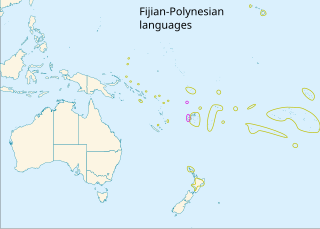Related Research Articles
Rotokas is a North Bougainville language spoken by about 4,320 people on the island of Bougainville, an island located to the east of New Guinea, which is part of Papua New Guinea. According to Allen and Hurd (1963), there are three identified dialects: Central Rotokas, Aita Rotokas, and Pipipaia; with a further dialect spoken in Atsilima (Atsinima) village with an unclear status. Central Rotokas is most notable for its extremely small phonemic inventory and for having perhaps the smallest modern alphabet.

The Polynesian languages form a genealogical group of languages, itself part of the Oceanic branch of the Austronesian family.
Mbula is an Austronesian language spoken by around 2,500 people on Umboi Island and Sakar Island in the Morobe Province of Papua New Guinea. Its basic word order is subject–verb–object; it has a nominative–accusative case-marking strategy.
The phonology of the Persian language varies between regional dialects, standard varieties, and even from older varieties of Persian. Persian is a pluricentric language and countries that have Persian as an official language have separate standard varieties, namely: Standard Dari (Afghanistan), Standard Iranian Persian (Iran) and Standard Tajik (Tajikistan). The most significant differences between standard varieties of Persian are their vowel systems. Standard varieties of Persian have anywhere from 6 to 8 vowel distinctions, and similar vowels may be pronounced differently between standards. However, there are not many notable differences when comparing consonants, as all standard varieties have a similar number of consonant sounds. Though, colloquial varieties generally have more differences than their standard counterparts. Most dialects feature contrastive stress and syllable-final consonant clusters. Linguists tend to focus on Iranian Persian, so this article may contain less adequate information regarding other varieties.
There is significant phonological variation among the various Yiddish dialects. The description that follows is of a modern Standard Yiddish that was devised during the early 20th century and is frequently encountered in pedagogical contexts.
Sulka is a language isolate of New Britain, Papua New Guinea. In 1991, there were 2,500 speakers in eastern Pomio District, East New Britain Province. Villages include Guma in East Pomio Rural LLG. With such a low population of speakers, this language is considered to be endangered. Sulka speakers had originally migrated to East New Britain from New Ireland.
Futuna-Aniwa is a language spoken in the Tafea Province of Vanuatu on the outlier islands of Futuna and Aniwa. The language has approximately 1,500 speakers. It is a Polynesian language, part of the Austronesian language family.
Yabem, or Jabêm, is an Austronesian language of Papua New Guinea.
Ughele is an Oceanic language spoken by about 1200 people on Rendova Island, located in the Western Province of the Solomon Islands.
Arosi is a Southeast Solomonic language spoken on the island of Makira. Arosi is primarily spoken by inhabitants who live to the west of the Wango River on Makira. Makira is in the easternmost part of the Solomon Islands. Makira was visited and named by Álvaro de Mendaña de Neira in 1588. Upon landing on Makira, the Spanish were the first to record Arosi, but only six words were initially recorded. Arosi is one of the lesser known languages in Melanesia.
In linguistics, clusivity is a grammatical distinction between inclusive and exclusive first-person pronouns and verbal morphology, also called inclusive "we" and exclusive "we". Inclusive "we" specifically includes the addressee, while exclusive "we" specifically excludes the addressee; in other words, two words that both translate to "we", one meaning "you and I, and possibly someone else", the other meaning "me and some other person or persons, but not you". While imagining that this sort of distinction could be made in other persons is straightforward, in fact the existence of second-person clusivity in natural languages is controversial and not well attested. While clusivity is not a feature of standard English language, it is found in many languages around the world.

Moloko (Məlokwo) is an Afro-Asiatic language spoken in northern Cameroon.
Kâte is a Papuan language spoken by about 6,000 people in the Finschhafen District of Morobe Province, Papua New Guinea. It is part of the Finisterre–Huon branch of the Trans–New Guinea language family. It was adopted for teaching and mission work among speakers of Papuan languages by the Evangelical Lutheran Church of Papua New Guinea in the early 1900s and at one time had as many as 80,000 second-language speakers.
This article discusses the phonology of the Inuit languages. Unless otherwise noted, statements refer to Inuktitut dialects of Canada.
Vanimo is a Skou language of Papua New Guinea which extends from Leitre to Wutung on the Papua New Guinea - Indonesian border.
The Xerénte or Akwẽ-Xerénte language is an Akuwẽ language of Brazil. It is spoken by the Xerente people in the Tocantins state between Rio do Sono and Rio Tocantins.

Ute is a dialect of the Colorado River Numic language, spoken by the Ute people. Speakers primarily live on three reservations: Uintah-Ouray in northeastern Utah, Southern Ute in southwestern Colorado, and Ute Mountain in southwestern Colorado and southeastern Utah. Ute is part of the Numic branch of the Uto-Aztecan language family. Other dialects in this dialect chain are Chemehuevi and Southern Paiute. As of 2010, there were 1,640 speakers combined of all three dialects Colorado River Numic. Ute's parent language, Colorado River Numic, is classified as a threatened language, although there are tribally-sponsored language revitalization programs for the dialect.
Sinaugoro is an Austronesian language of Papua New Guinea. It is mainly spoken in the Rigo District of Central Province by some 15,000 people. The language is closely related to Motu.
Neveʻei, also known as Vinmavis, is an Oceanic language of central Malekula, Vanuatu. There are around 500 primary speakers of Neveʻei and about 750 speakers in total.
Proto-Admiralty Islands is the reconstructed ancestor of the Admiralty Islands languages of the Admiralty Islands, located in Papua New Guinea. It belongs to the Oceanic branch of the Austronesian languages.
References
- Wivell, Richard (1981). Kairiru grammar. M.A. thesis, University of Auckland.